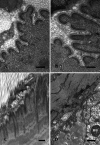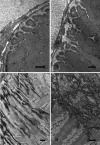How physical exercise changes rat myotendinous junctions: an ultrastructural study
- PMID: 22688300
- PMCID: PMC3428968
- DOI: 10.4081/ejh.2012.19
How physical exercise changes rat myotendinous junctions: an ultrastructural study
Abstract
Myotendinous junctions can be easily injured by overloading or trauma, and exercise training may be a way of increasing their resistance to mechanical stress. To this end, we examined herein the morphological changes induced by moderate exercise training in the myotendinous junctions of extensor digitorum longus and gastrocnemius muscles in rats. Twelve Sprague-Dawley rats were used in this investigation. Six of them were trained to run on a treadmill for 1 h/day, 3 days/week over 10 weeks in order for them to achieve a running rate of 25 m/min at the end of the training period. Six age-matched sedentary rats were used as controls. The rats were sacrificed 24 h after the final training session, and the extensor digitorum longum (EDL) and the gastrocnemium were excised; the myotendinous junctions (MTJ) were then prepared and observed with electron microscopy. Digitation branching was evaluated by counting the bifurcations in the MTJ protrusions. Our observations indicate that exercise does indeed induce changes in MTJ morphology. In both muscles the number of bifurcated interdigitations increased significantly, as well as, in gastrocnemius, the branching of the finger-like processes. It was demonstrated that the MTJ is able to adapt to an increase in tensile force by enlarging the muscle-tendon contact area and, consequently, mechanical resistance.
Figures





Similar articles
-
Effect of Different Exercise Intensities on the Myotendinous Junction Plasticity.PLoS One. 2016 Jun 23;11(6):e0158059. doi: 10.1371/journal.pone.0158059. eCollection 2016. PLoS One. 2016. PMID: 27337061 Free PMC article.
-
Myotendinous junction plasticity in aged ovariectomized rats submitted to aquatic training.Microsc Res Tech. 2018 Aug;81(8):816-822. doi: 10.1002/jemt.23040. Epub 2018 Apr 24. Microsc Res Tech. 2018. PMID: 29689628
-
Ultrastructural changes at the myotendinous junction induced by exercise.J Orthop Sci. 2008 May;13(3):233-9. doi: 10.1007/s00776-008-1211-0. Epub 2008 Jun 6. J Orthop Sci. 2008. PMID: 18528657
-
Force transmission across muscle cell membranes.J Biomech. 1991;24 Suppl 1:43-52. doi: 10.1016/0021-9290(91)90376-x. J Biomech. 1991. PMID: 1791181 Review.
-
Engineering interfacial tissues: The myotendinous junction.APL Bioeng. 2024 Jun 3;8(2):021505. doi: 10.1063/5.0189221. eCollection 2024 Jun. APL Bioeng. 2024. PMID: 38841690 Free PMC article. Review.
Cited by
-
Myotendinous Junction: Exercise Protocols Can Positively Influence Their Development in Rats.Biomedicines. 2022 Feb 18;10(2):480. doi: 10.3390/biomedicines10020480. Biomedicines. 2022. PMID: 35203688 Free PMC article.
-
Growth hormone plus resistance exercise attenuate structural changes in rat myotendinous junctions resulting from chronic unloading.Eur J Histochem. 2013 Nov 13;57(4):e37. doi: 10.4081/ejh.2013.e37. Eur J Histochem. 2013. PMID: 24441190 Free PMC article.
-
Effects of physical training on sarcomere lengths and muscle-tendon interface of the cervical region in an experimental model of menopause.Eur J Histochem. 2019 Aug 6;63(3):3038. doi: 10.4081/ejh.2019.3038. Eur J Histochem. 2019. PMID: 31455072 Free PMC article.
-
Nestin and osteocrin mRNA increases in human semitendinosus myotendinous junction 7 days after a single bout of eccentric exercise.Histochem Cell Biol. 2022 Jul;158(1):49-64. doi: 10.1007/s00418-022-02101-4. Epub 2022 Apr 15. Histochem Cell Biol. 2022. PMID: 35428952 Clinical Trial.
-
Ultrastructural histochemistry in biomedical research: Alive and kicking.Eur J Histochem. 2018 Nov 7;62(4):2990. doi: 10.4081/ejh.2018.2990. Eur J Histochem. 2018. PMID: 30418011 Free PMC article.
References
-
- Law DJ, Allen DL, Tidball JG. Talin, vinculin and DRP (utrophin) concentrations are increased at mdx myotendinous junctions following onset of necrosis. J Cell Sci. 1994;107:1477–83. - PubMed
-
- Tidball JG. Assembly of myotendinous junctions in the chick embryo: deposition of P68 is an early event in myotendinous junction formation. Dev Biol. 1994;163:447–56. - PubMed
-
- Rodriguez-Guzman M, Montero JA, Santesteban E, Gañan Y, Macias D, Hurle JM. Tendon-muscle crosstalk controls muscle bellies morphogenesis, which is mediated by cell death and retinoic acid signaling. Dev Biol. 2007;302:267–80. - PubMed

